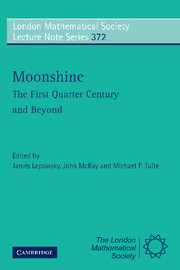 Moonshine - The First Quarter Century and Beyond
Moonshine - The First Quarter Century and Beyond Book contents
- Frontmatter
- Contents
- Preface
- Schedule of Talks
- Characters of Crossed Modules and Premodular Categories
- On the Injectivity of the Kudla-Millson Lift and Surjectivity of the Borcherds Lift
- Ordered Spanning Sets for Vertex Operator Algebras and their Modules
- Friendly Giant Meets Pointlike Instantons? On a New Conjecture by John McKay
- Modularity of Trace Functions in Orbifold Theory for ℤ-Graded Vertex Operator Superalgebras
- Twisted Modules for Vertex Operator Algebras
- Vertex Operators and Sporadic Groups
- The Algebraic Meaning of Being a Hauptmodul
- Borcherds' Proof of the Conway-Norton Conjecture
- On the Connection of Certain Lie Algebras with Vertex Algebras
- Vertex Operators and Arithmetic: How a Single Photon Illuminates Number Theory
- Rational Vertex Operator Algebras and their Orbifolds
- Quasi-finite Algebras Graded by Hamiltonian and Vertex Operator Algebras
- On Certain Automorphic Forms Associated to Rational Vertex Operator Algebras
- Moonshine and Group Cohomology
- Monstrous and Generalized Moonshine and Permutation Orbifolds
- New computations in the Monster
On Certain Automorphic Forms Associated to Rational Vertex Operator Algebras
Published online by Cambridge University Press: 06 July 2010
- Frontmatter
- Contents
- Preface
- Schedule of Talks
- Characters of Crossed Modules and Premodular Categories
- On the Injectivity of the Kudla-Millson Lift and Surjectivity of the Borcherds Lift
- Ordered Spanning Sets for Vertex Operator Algebras and their Modules
- Friendly Giant Meets Pointlike Instantons? On a New Conjecture by John McKay
- Modularity of Trace Functions in Orbifold Theory for ℤ-Graded Vertex Operator Superalgebras
- Twisted Modules for Vertex Operator Algebras
- Vertex Operators and Sporadic Groups
- The Algebraic Meaning of Being a Hauptmodul
- Borcherds' Proof of the Conway-Norton Conjecture
- On the Connection of Certain Lie Algebras with Vertex Algebras
- Vertex Operators and Arithmetic: How a Single Photon Illuminates Number Theory
- Rational Vertex Operator Algebras and their Orbifolds
- Quasi-finite Algebras Graded by Hamiltonian and Vertex Operator Algebras
- On Certain Automorphic Forms Associated to Rational Vertex Operator Algebras
- Moonshine and Group Cohomology
- Monstrous and Generalized Moonshine and Permutation Orbifolds
- New computations in the Monster
Summary
Abstract
To every rational vertex operator algebra V we associate an automorphic form on Г′ (1) that we call the Wronskian of V. We have previously shown [M2], [M3] that in the case of Virasoro minimal models it is possible to give qualitative arguments about the Wronskian by using the representation theoretic methods. Here we apply the theory of automorphic forms and extend our previous work to a larger class of vertex operator algebras. We also give a detailed analysis of two-dimensional modular invariant spaces that arise from affine Kac-Moody Lie algebras.
As a main byproduct of our analysis we provide new proofs of certain Dyson-Macdonald's identities for powers of the Dedekind η–function for Cl, BCl and Dl series, and related identities (e.g., Jacobi's Four Square Theorem).
Introduction and notation
The existence of a fusion ring and modular invariance of graded dimensions, or characters, are the most interesting features of every rational conformal field theory [MS]. When it comes to vertex operator algebra theory, proving modular invariance [Zh] (cf. [DLM1]) and ultimately the Verlinde formula [Hu1] is a formidable task. A key ingredient in proving modular invariance is played by the so-called C2–cofiniteness [Zh] which, in particular, guarantees the convergence of all one-point functions on the torus. The C2–cofiniteness plays an important role in the proof of the Verlinde conjecture as well [Hu1]. Even though the vector space spanned by irreducible characters is a PSL(2,ℤ)–module (i.e., a modular invariant space), one cannot state the Verlinde formula without having an action of SL(2,ℤ) (the operator S2 does not act as the identity in general–charge conjugation).
- Type
- Chapter
- Information
- Moonshine - The First Quarter Century and BeyondProceedings of a Workshop on the Moonshine Conjectures and Vertex Algebras, pp. 330 - 357Publisher: Cambridge University PressPrint publication year: 2010
- 4
- Cited by
